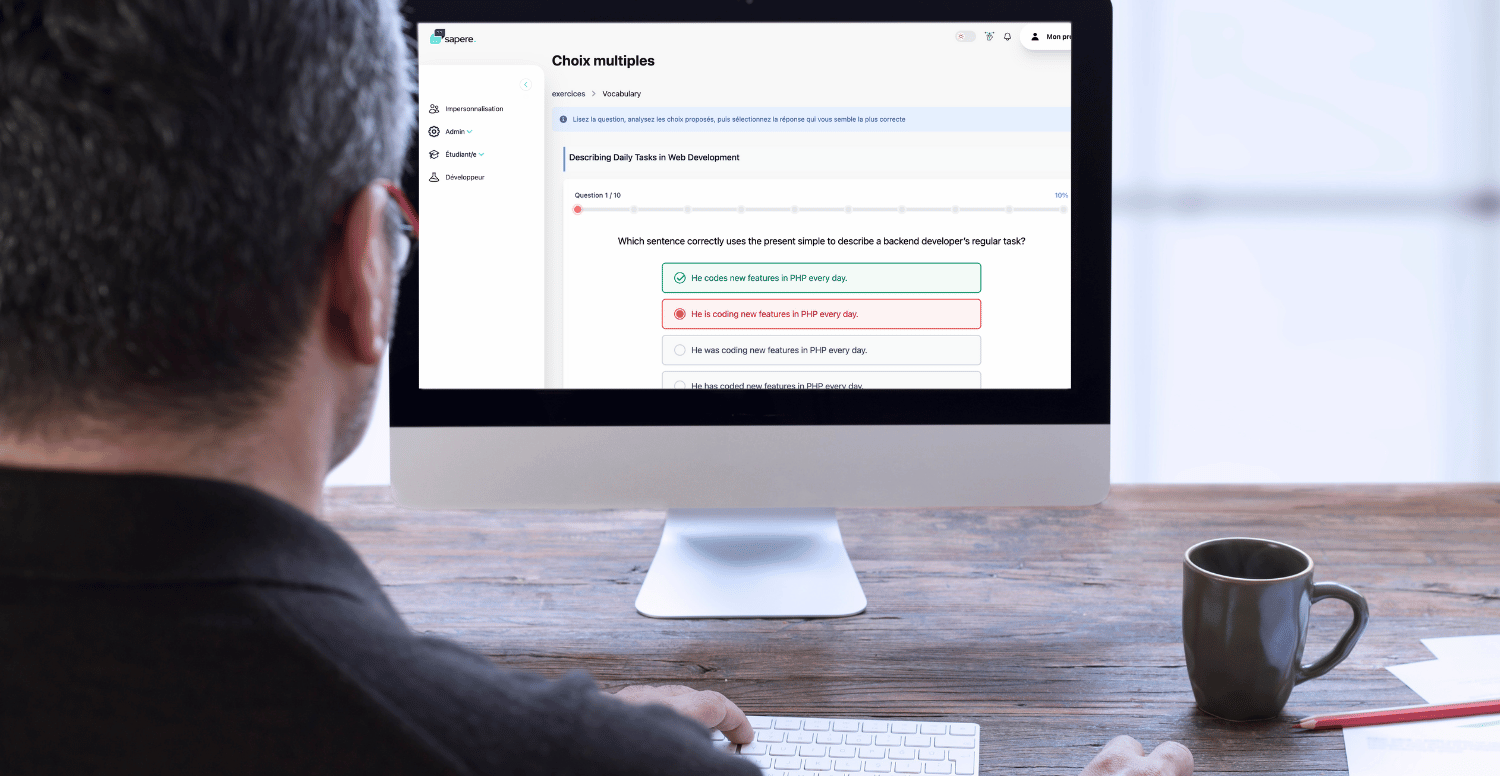
How to Use Artificial Intelligence in Employee Training?
Table of Contents
Does your business offer employee training? In theory, training your staff allows them to acquire or reinforce certain competencies that enhance their work and increase productivity. In practice however, these training sessions can be costly and tricky to fit into everyone’s schedules. The solution? Rely on artificial intelligence to offer customized training, adapted to your business’ needs!
In this article, we will explore how AI can assist companies seeking to implement workplace training. We will also delve into how AI can be utilized to teach employees a second language at work.
Artificial Intelligence for Workplace Training: How Can It Be Used?
Nowadays, AI is everywhere, whether it be accessible on a daily basis via our phones, or integrated into every communication or organization platform we use on the job. Yes, artificial intelligence exists, but how can we make use of it to help our employees?
Create a Training Course With AI
Investing in a generalized training course for employees can be risky, as it often leads to them learning basic information that does not pertain to their particular job, or worse, re-learning things they already know. This is where AI can make all the difference: by creating training courses according to your company’s field, your employees’ needs, their availability, etc.
By generating content through educational platforms such as Notion AI, ChatGPT or Jasper, you can create relevant content and a fully customized training course. Better yet, to ensure employees retain the information they learned, the AI can also create quizzes, summary sheets or case studies, thus helping reinforce the material.
Automate and Optimize the Training Process
Artificial intelligence creates more efficient employee training that is tailored to the individual, primarily by analyzing their progress, their pace, their weak points, etc. This is how AI integrated into platforms such as Moodle, 360Learning and Talentsoft can:
Track each student’s progress.
Identify their weak points (a module they did not understand, repeated absences).
Automatically suggest new content or exercises depending on the individual’s needs.
For example, if an employee is following a cybersecurity training course, the AI platform can detect if they are having issues understanding the segment regarding “phishing”. It will then be able to suggest an additional revision module about this subject, before testing the employee on their knowledge.
Moreover, the AI can also enact the role of “assistant trainer”. For instance, an AI chatbot can answer students’ questions in real time, explain difficult-to-understand concepts or generate practice quizzes.
Teach Employees to Use AI
In addition to its applications in workplace training, artificial intelligence has become more and more prevalent in organizational tools. With AI’s advent in the professional world, it is important for employees to learn to use it properly, and to understand its limitations.
It is possible to organize workshops or training sessions to teach employees to use tools such as ChatGPT, Notion AI or Microsoft Copilot. These trainings can demonstrate how to automate certain tasks (like summarizing long texts or generating a report), or how to properly write a prompt, meaning to formulate proper requests, so the AI can provide you with the best results.

Why Integrate AI Into Language Learning in the Workplace?
Being multilingual is an undeniable asset for businesses. However, very few companies actually offer language training to develop their employees’ competencies. Why? Because learning a language in the workplace is often seen as a long, expensive and harrowing process. This is where AI comes in: it allows for a more efficient, personalized and flexible learning environment. All in all, AI enables a better return on investment.
Companies’ Specific and Varied Needs
When we decide to learn a new language in the workplace, it is generally to meet particular needs that are inherent to said company. Certain people choose to focus on Business English to better communicate with international clients. To comply with francisation requirements in some parts of the world, companies may rely on courses that teach French as a second language. Finally, some businesses implement Spanish courses to improve communication and job safety for their foreign workers.
Additionally, knowing a second language is not always enough to be efficient on the job, especially if you only ever learned the basics. Certain companies require courses specifically centred around customer service, where the staff learns to hold a conversation in subjects that come up on the regular. Others need to teach employees the techniques of a negotiation or the best way to give a presentation in a meeting. It is also possible for some businesses to focus more on written competencies, mainly to ensure their staff can write coherent and detailed emails.
Choosing an AI That Meets Three Main Requirements
Choosing to use AI as an educational tool in language learning is ensuring to meet three essential criteria: flexibility, personalization and interactivity. Sapere was created with this in mind: to personalize workplace language training while meeting these vital requirements.
Flexibility
Language learning cannot get in the way of a company’s daily operations. It is not easy to block off an entire afternoon so that several employees may attend a group class. Thanks to Sapere, the AI-powered learning platform, employees can learn at their own pace, at any time; whether it be from home, or at work, during their lunch break. The student can choose to practice in short study sessions to maintain their fluency, or longer ones to delve deeper into the theory.
Personalization
No more basic, copy-pasted courses! With artificial intelligence, businesses can quickly personalize courses to tailor them to their employees’ daily lives. Better yet, the content can be adjusted to the individual’s language level and their particular position in the company. Everything is customized, from the curriculum to the exercises.
Interactivity
Learning basic vocabulary and doing exercises created for schools will never help workers reach levels B2 or C1 on the CEFR assessment. To make meaningful progress, it is important to practice handling real-life situations. This is another reason artificial intelligence is such an asset; it generates personalized exercises based on situations the employee frequently encounters on the job. These exercises include role-playing, listening comprehension in the context of a phone call with a client, writing an email for the AI to correct, etc. Learning becomes entirely interactive!
AI tools enable relevant and motivating personalized learning: as a result, employees make progress faster.
Practical Applications of AI for Foreign Language Learning in the Workplace
We just covered how AI can fulfill three essential requirements for businesses wishing to offer language courses. The logical next question is: how can artificial intelligence support HR and its trainers in teaching their employees a new language?
Assessing Language Level With AI
It is essential for each participant of a second language course to know their language level before getting started. It is not an option to base their needs on an assumption or offer a generalized intermediate course, as this would risk wasting their time as well as that of the teacher. Worst-case scenario would be a teacher needing multiple sessions with a student before gaging their level.
Offering an automated level-assessment test powered by AI could sidestep this issue altogether, by analyzing employees’ knowledge of grammar rules, pronunciation and vocabulary.
Generating Customized Content
As previously mentioned, a language course offered by a company is more effective if the contents of said course are tailored to the employee and their profession. In addition to improving motivation, these personalized courses allow students to make better progress and retain their lessons in the long term.
With the help of artificial intelligence, Sapere offers:
Exercises tailored to the profession (e.g.: technician, HR, accountant, sales).
Precise vocabulary lists centered on a professional lexical field.
Realistic role-playing exercises with personalized case studies (e.g. : negotiation, call with a client).
Speaking Exercises With AI Chatbots
The best way to practice one’s oral expression and ensure that someone is there to catch their errors, is with a teacher. This is what Global Lingua aims to accomplish with their private online language courses focused on conversation. That being said, it is helpful to be able to practice on your own between classes; this is now possible with the help of AI.
With artificial intelligence, you can now converse with chatbots in writing or by speaking (mainly in English or in French), or initiate role-playing exercises such as ordering from a restaurant or asking for directions.
Even better, certain AI platforms offer immediate corrections and feedback in regards to fluency and tone. These programs mainly include Grammarly and LanguageTool, which allow students to improve their writing skills or ask how to reformulate their texts (to make them more polite, clear, concise, etc.).

How to Effectively Implement AI in Language Training for Employees
Set Learning Objectives
Before starting an AI language course, it is important to know what the goal is. Do you want employees to reach level A2 (beginner), B1 (intermediate) or B2 (autonomous)? Are you working with students that need to start from scratch, or ones that want to improve certain competencies, like oral expression? Sometimes, these answers depend on the needs of each job position.
For the AI to be as specific as possible in its teaching, it is helpful to inform it of different contexts the language will be used in, whether it be writing professional emails, making phone calls, or taking charge of meetings and presentations. These factors will help in deciding which tools and content will be most useful to your team.
Use the Right AI Tools
It is essential to select the tools and services best suited for a business’ objectives in order to promote effective learning.
Platforms centered around artificial intelligence, such as Sapere, allow for:
Tracking students’ progress.
Generating personalized exercises.
Sending reminders that promote frequent practice.
Services such as Global Lingua, Gymglish or Duolingo offer:
Short and interactive activities.
Content tailored to the student’s language level.
An engaging experience, thanks to AI adjusting the difficulty accordingly.

Integrate AI Into Everyday Tools
To encourage employees to practice regularly, it could be useful to integrate AI into software that employees already use at work.
For example, in Outlook or Gmail, AI can offer corrections or suggest different reformulations in English or in French. Additionally, Google Docs and Slack have AI tools that can help enhance sentences or translate common expressions. This makes reformulating texts easier, creates a more natural result, and above all, students can learn while working.
Involve HR and Management
Human resources and managers must be included in the process of integrating AI into employee training, especially when it is used for language learning. They can:
Track employees’ progress through the dashboard.
Encourage staff to use the tools regularly.
Congratulate continued effort, perhaps with digital badges or printed certificates.
This strengthens employees’ motivation and confidence in using these tools. It also demonstrates the thought that went into developing this training program, as well as the company’s appreciation for those who follow it.
Raise Awareness of Ethical Practices
Careful: while IA is an excellent tool, it has not yet been perfected. Learning a language can be complicated and require the help of experts, such as qualified language teachers. Thus, while undergoing training via an AI, it is important to:
Verify the generated content, as certain responses can be unverified or incorrect.
Encourage critical thinking by remembering that AI can act as an aid, but cannot replace human reasoning. This is exactly why Sapere can be used alongside a qualified teacher.
Promote autonomy: students must learn to use AI as an assistant, not as a crutch.
In conclusion, since AI allows for more efficient, pertinent and motivating language learning in the workplace, it would be a shame to pass up such an opportunity. However, you must keep in mind that AI, platforms that integrate AI or even language learning tools, exist to offer personalized content as well as complement the educator’s work, not replace it.
Bonus : FAQ on the Uses of Artificial Intelligence for Employee Training
Which AI should I use to learn a language in the workplace?
👉 Use Sapere to generate personalized course material and exercises tailored to the business’ professional field, ChatGPT to practice conversation, and Global Lingua to interact with qualified teachers who are accustomed to using AI.
How can AI help me learn a new language?
👉 It creates personalized content, suggests corrections in real time, and simulates professional conversations. This allows for an efficient and effective learning process.
How do I use AI to learn a language?
👉 AI is the ideal addition to any online course, mainly because it personalizes content, enables students to practice oral expression with chatbots, and automatically analyzes and provides feedback on errors.
Does AI replace language courses?
👉 No, it complements them by encouraging students to practice between sessions and adapting content to their professional field. We recommend using online courses with Global Lingua in tandem with the AI learning platform, Sapere.


